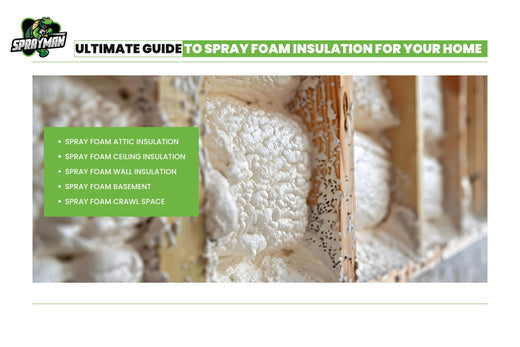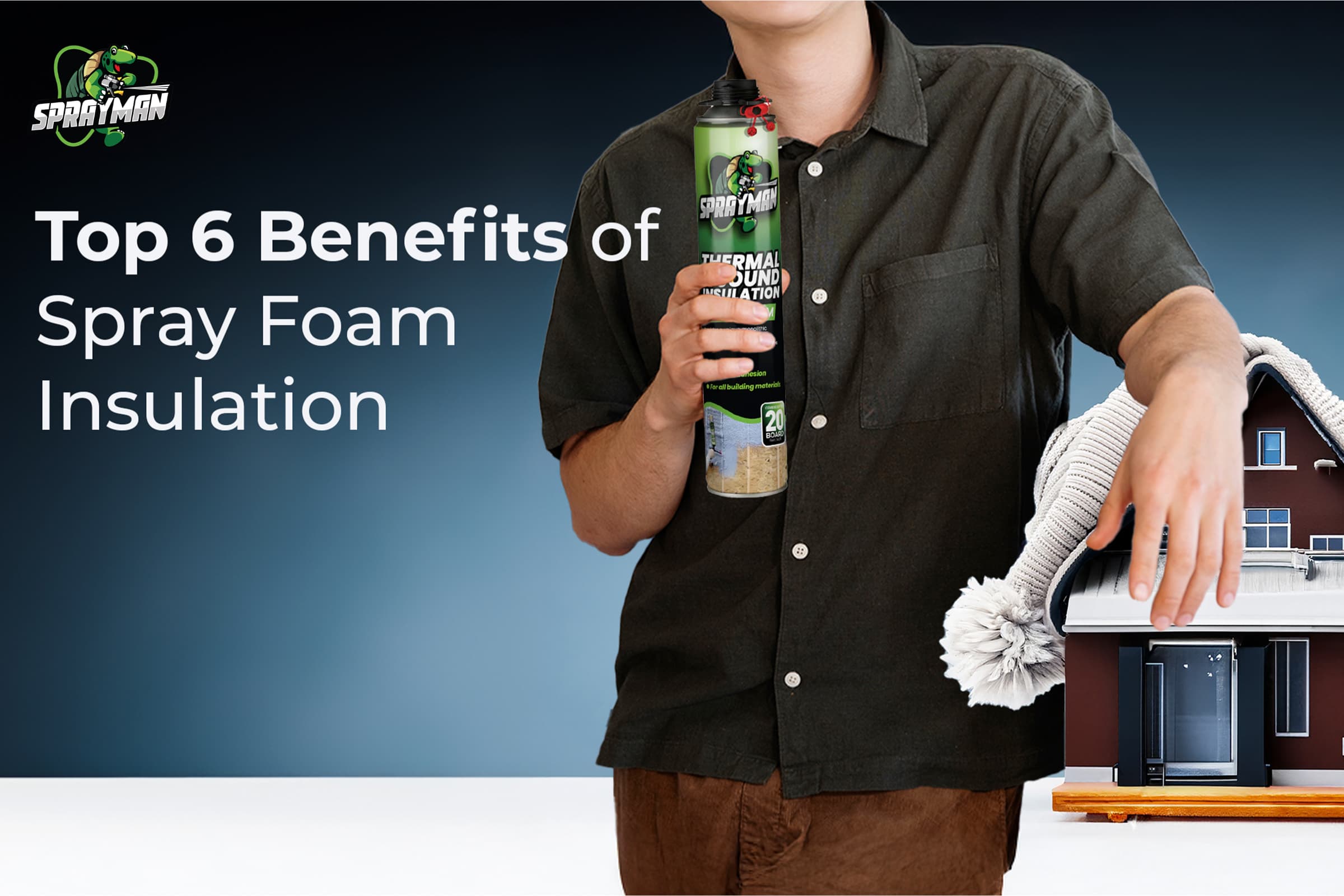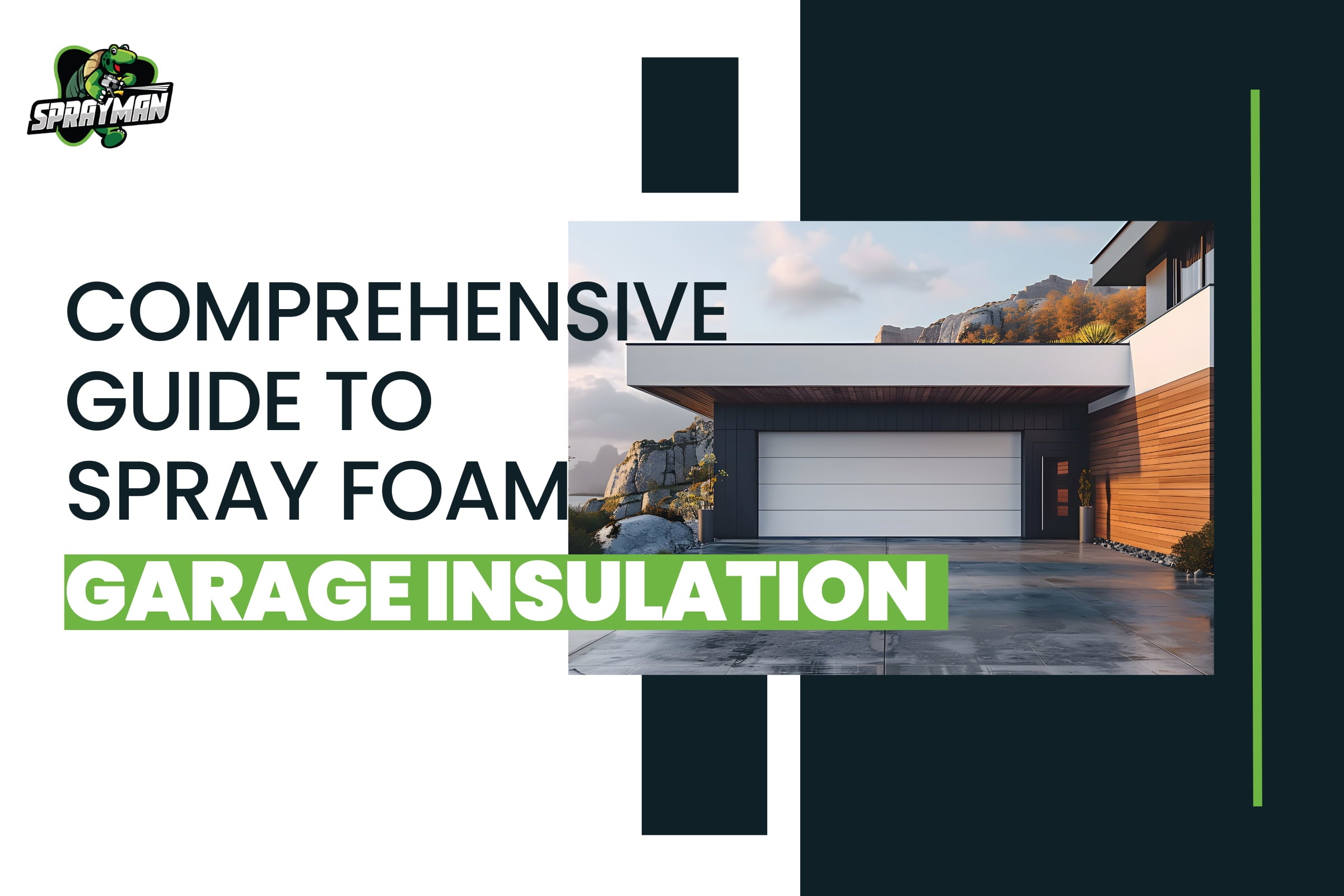Spray foam insulation is the most reliable solution to achieving energy efficiency in your home. It creates a thermal envelope around your building, covering the building from the roof to its crawl space. Spray foam insulation is popular for its versatility, thermal performance, and moisture resistance.
Insulation involves sealing the common entry points for air infiltration in buildings. The primary focus areas for heat transfer in a building include the roof, attic, ceiling, basement, and crawl space. Proper insulation creates a thermal envelope that covers the whole living area. Insulating one area in your home and neglecting the others defeats the aim of insulation.
This post is all you need to begin your first insulation project. In addition, this post includes the pros and cons of spray foam insulation for different areas in your building. Lastly, we included DIY guides on the following;
- Spray foam attic insulation
- Spray foam ceiling insulation
- Spray foam wall insulation
- Spray foam basement
- Spray foam crawl space

Why Insulating Your Home Is Crucial?
Home insulation is the process of creating a thermal barrier between your living area and the surrounding environment. Insulating your home creates a thermal envelope around the building. Proper insulation is vital in improving energy efficiency and overall living conditions in buildings.
Insulation in your home prevents air leaks through different areas such as the attic, wall, crawl, roof, and basement. Insulation slows down heat transfer and helps lower energy consumption. Moisture resistance and soundproofing are also some of the advantages of insulating your home.
Insulating your home is an investment, and the first step is choosing the right insulation material. The effectiveness of insulation is dependent on several factors, such as R-value, water resistance, and soundproofing capabilities. Spray polyurethane foam has grown to become the most effective material for home insulation. It fits into small cracks, crevices, and gaps. Spray foam dries quickly to provide excellent thermal and moisture resistance.
What Is The Best Insulation For Homes?
The best insulation for an attic, basement, crawl space, and wall is closed-cell spray foam insulation. Spray foam insulation expands rapidly to fill tiny spaces in your home, creating a strong barrier against heat loss, pest, and moisture problems. Spray foam insulation r-value for closed-cell is R6 - R7 per inch thickness. Spray foam insulation closed-cell is dense, does not retain water, and offers good acoustic properties.
The numerous benefits of spray foam insulation make it suitable for insulating different areas in your home. The walls and attic account for 50% of heat loss in a building. Thus, spray foam wall insulation and attic foam insulation are vital in reducing energy consumption in your home. Furthermore, spray foam is the ideal insulation for hard-to-reach areas in the home. This is evident in the spray foam basement and spray foam crawl space.

What Are The Pros And Cons Of Spray Foam Insulation?
Spray foam insulation is popular because of its versatility; it is used to seal different areas of a building. Spray foam is ideal for insulating a roof, basement, crawlspace, and ceiling. Despite the top 6 benefits of installing spray foam insulation, there are still a few disadvantages. In this section, we will highlight the pros and cons of spray foam insulation.
Pros Of Spray Foam Insulation For Different Areas
Here are 5 advantages of spray foam insulation for different areas in your home;
- Lower Energy Bills: Spray foam insulation lowers energy bills in buildings by reducing energy consumption. Spray foam attic reduces heating costs in your home by preventing air leakages through the attic. This is also applicable to other areas in your home. You can reduce 30% of energy consumption when spray foam is properly installed in different areas of your home.
- Improved Home Comfort: Spray foam insulation improves home comfort all year round. It improves indoor air quality by preventing air-borne pollutants in your living area. Foam insulation eliminates drafts in different areas where it is installed. Spray foam insulation acts as pest deterrence in homes. It is commonly used for basement insulation as it helps block common entry points for pests and rodents.
- Moisture Resistance: Closed-cell spray foam insulation has a dense structure. Thus, it provides strong resistance against moisture and condensation. Spray foam helps to prevent mold problems in basements, walls, and crawls. This makes spray foam insulation the ideal material for flood-prone areas.
- Air sealing: Spray foam insulation provides excellent air sealing properties in different areas. It fills tiny cracks that can cause leaks in the attic, wall, and ceiling.
- Eco-friendly: Spray foam insulation offers a positive impact on the environment. It is made using sustainable materials with low GWP. As a homeowner, you can lower your building’s carbon footprint by adding insulation in an attic and other areas.
Cons Of Spray Foam Insulation For Different Areas
Here are 2 drawbacks of spray foam for different areas;
- Expensive: Spray foam insulation is expensive compared to other insulation options. Spray foam insulation costs an average of $6,000 for a 1,000 sq ft area.
- Requires a professional installation: As a beginner, you should consider hiring professionals for your insulation job. Improper installation can cause off-gassing, among other complications.
Detailed Guides For DIY Spray Foam Insulation
As a homeowner, you should learn how to carry out DIY spray foam. It is cost-effective, and you will get better with more practice. The trick to getting better is starting with small-scale projects. Here is the list of items you need for DIY spray foam insulation;
- SPRAYMAN Spray Foam Thermal and Sound Insulation
- DIY Spray Foam Kit (spray guns, nozzles, protective gear)
- Plastic sheeting or Drop cloth
- Utility knife
- Ladder
Spray Foam Attic Insulation And Spray Foam Roof Insulation
Attic and roof insulation are the first steps to reducing heat loss in your home. Installing spray foam attic insulation and spray foam roof insulation will reduce energy consumption by the HVAC system by 30%.
Before you begin your installation, find out why attics and roofs are ideal for spray foam insulation.
Here is a step-by-step guide on DIY spray foam insulation;
- Get the necessary materials before you begin installation.
- Wear protective Equipment.
- Prepare the attic and roof for insulation by removing debris or dirt.
- Apply spray foam insulation evenly on the roof and attic.
- Allow it to dry.
- Smoothen the foam.
- Inspect the foam.
Spray Foam Wall Insulation And Spray Foam Ceiling Insulation
Wall insulation and ceiling insulation are necessary to improve energy efficiency in your home further. In addition, proper insulation using spray foam provides structural support in a building. Spray foam is suitable for all wall types, as discussed in this ultimate guide on spray foam insulation on walls and ceilings.
Here is a DIY guide on installing spray foam wall insulation and spray foam ceiling insulation.
- Prepare the wall and ceiling by removing the debris or obstruction. It is important to know how to remove drywall. Remove all electrical components and ensure proper ventilation. Spread the plastic sheeting or drop clothes on the floor to minimize spills.
- Protect your eyes, skin, and nose with the right protective equipment.
- Apply spray foam on the ceiling and then move to the walls.
- Allow curing for at least 24 hours.
- Remove excess foam using a utility knife.
- Inspect the job and apply spray on missed spots.
Spray Foam Crawl Space
Crawl space spray foam insulation is necessary to avoid having cold floors in your home. Hiring a professional for spray foam insulation crawl space is expensive because of its complexity. Nevertheless, DIY insulation eliminates the cost of hiring a contractor. Here is how you can insulate your crawl space with spray foam;
- Clear the crawl space by removing debris. Prepare the area for insulation by checking electrical or plumbing fixtures in the crawl space.
- Wear protective equipment.
- A vapor barrier should be installed on the ground.
- Apply spray foam evenly on the rim joist and crawl space walls.
- Allow spray foam to cure properly after application. Curing time should be 24 hours.
- Inspect the work.
Spray Foam Basement Insulation
Basement insulation improves the living conditions of your basement significantly. Different areas in a basement require insulation to create an airtight environment. This ultimate guide on spray foam basement insulation highlights the importance of insulating these areas and everything regarding basement insulation.
Here is a DIY guide on spray foam basement insulation;
- Prepare your basement for insulation by addressing mold issues, water leaks, debris, and existing insulation.
- Protect your eyes, nose, and skin before you begin application.
- Apply spray foam in the 3 different areas of your basement. First, begin with basement wall insulation. Apply spray foam evenly on the wall studs. Next, focus on basement ceiling insulation. Lastly, apply spray foam on the basement floor.
- Allow the foam to cure properly. Next, remove excess foam to achieve a smooth finish.
- Inspect the installation.
How To Maintain Your Spray Foam Insulation?
Naturally, spray foam insulation is extremely durable and has a long lifespan. Regular maintenance is required to sustain its effectiveness over a long period. With proper maintenance, spray foam insulation will last a lifetime.
Here are 5 tips on how to maintain spray foam insulation;
- Fix leaks and cracks immediately.
- Avoid physical damage to your insulation.
- Perform visual inspection of insulation as often as possible.
- Clean debris regularly.
- Hire a professional for a routine check.
What Are The Environmental And Health Impacts Of Spray Foam Insulation?
Isocyanates and polyol resin are chemical compounds mixed to form spray polyurethane foam. These chemical compounds have several positive environmental impacts and potential health risks. As a homeowner, it is important to acquaint yourself with the environmental impact, risks, and safety precautions.
Environmental Benefits Of Spray Foam Insulation
Spray foam insulation offers environmental benefits in the following ways;
- Energy Efficiency: Spray foam insulation primarily improves the energy efficiency of a building. Reduced energy consumption translates to a significantly low carbon footprint in the building.
- Low VOCs: Quality spray foam product is made with low Volatile Organic Compounds (VOCs). Thus, they have low GWP and are environmentally friendly.
Potential Health Risks And Safety Precautions
Naturally, isocyanates are toxic compounds, and prolonged exposure can irritate the eyes, skin, and nose. Isocyanates are also known to trigger asthma and cause cancer. Improper installation and inadequate curing also cause the off-gassing of these toxic chemicals.
Here are 5 safety precautions that you must follow for a perfect insulation job;
- Allow adequate ventilation during spray foam insulation.
- Shake the spray foam very well before application,
- Always put Personal Protective Equipment (PPE) during installation.
- Remove existing spray foam insulation before adding a new one
- As a beginner, hire a professional for your spray foam insulation project.
FAQs
Can Contractors Use Spray Foam Insulation in a Can?
Spray foam insulation cans are especially suitable for small-scale insulation and DIY projects. They are easier to handle and cost-effective. Contractors use spray foam insulation for all kinds of areas including hard-to-reach projects such as spray foam insulation crawl space and spray foam basement insulation.
Should You Install Spray Foam Insulation Yourself Or Hire A Professional?
DIY spray foam insulation eliminates the cost of hiring expensive contractors for your insulation. Installing spray foam insulation is easy but highly delicate. DIY spray foam should be carried out carefully.
What is a Thermal Envelope?
A thermal envelope is the barrier that separates the conditioned (heated or cooled) indoor spaces of a building from the unconditioned outdoor environment. It includes the insulation, windows, doors, and walls that help maintain a consistent indoor temperature by preventing heat transfer between the inside and outside.
Which Construction Materials Are Suitable for Spray Foam Insulation?
Spray foam insulation is also popular for its versatility, it is applied on several construction materials. Concrete, wood, metals, and dry walls are some of the common construction materials that are suitable with spray foam insulation.
Is Foam Insulation Waterproof?
Due to its dense structure, closed-cell spray foam insulation offers superior resistance to moisture. On the other hand, open-cell spray foam is not waterproof. Unlike closed-cell, open-cell foam insulation absorbs water easily.
Does Spray Foam Insulation Reduce Noise?
One of the benefits of spray foam insulation is its soundproofing capabilities. Spray foam creates a sound barrier in buildings that blocks out unwanted noise. Open-cell spray foam provides better soundproofing as it absorbs sound easily.
What Are the Different Types of Spray Foam Insulation Available?
There are two distinct types of spray foam insulation; closed-cell and open-cell spray foam insulation. Learn more about the specific types of spray foam insulation, including open-cell and closed-cell options, in our detailed comparison guide on "Find Your Ideal Type of Spray Foam Insulation: Open vs. Closed Cell Explained."
Which Insulation Is First: Attic Or Under House?
Spray foam attic insulation should be considered first before under-house insulation. The attic is one of the building's entry points for heat transfer. During summer, hot air enters from the outside and builds up in the attic, making it more difficult for the HVAC system to cool the air in the house adequately. A poorly insulated attic allows heat loss, which causes significant energy consumption in homes.
Spray insulation under house is also important as it helps eliminate cold floors and reduce energy consumption. Both areas are necessary to create an energy-efficient building.
How Much Does Spray Foam Insulation Cost?
The average cost of installing spray foam insulation in your home is $6,000. This value is based on several factors that are explained in this comprehensive guide on spray foam insulation costs.
Can Spray Foam Insulation Improve Indoor Air Quality?
Improving indoor air quality is one of the main benefits of installing spray foam insulation in a building. Spray foam creates an airtight environment, preventing airborne pollutants from entering your living area.
Can You Be Home During Spray Foam Insulation?
No, staying where spray foam insulation is being installed without wearing PPE is harmful. During installation, spray foam gives off toxic chemicals into the atmosphere. These chemicals require ventilation and curing to leave your home. Always allow spray foam insulation to cure for at least 24 hours.
How to Trim Expanded Foam to Shape It?
Trimming expanded foam to shape is done after proper curing. There are several cutter tools to use depending on the project size and the type of foam. For open-cell spray foam that is lighter, you can use a serrated blade. Use a file for a small closed-cell project and a saw or utility knife for a bigger project.




Leave a comment
This site is protected by hCaptcha and the hCaptcha Privacy Policy and Terms of Service apply.